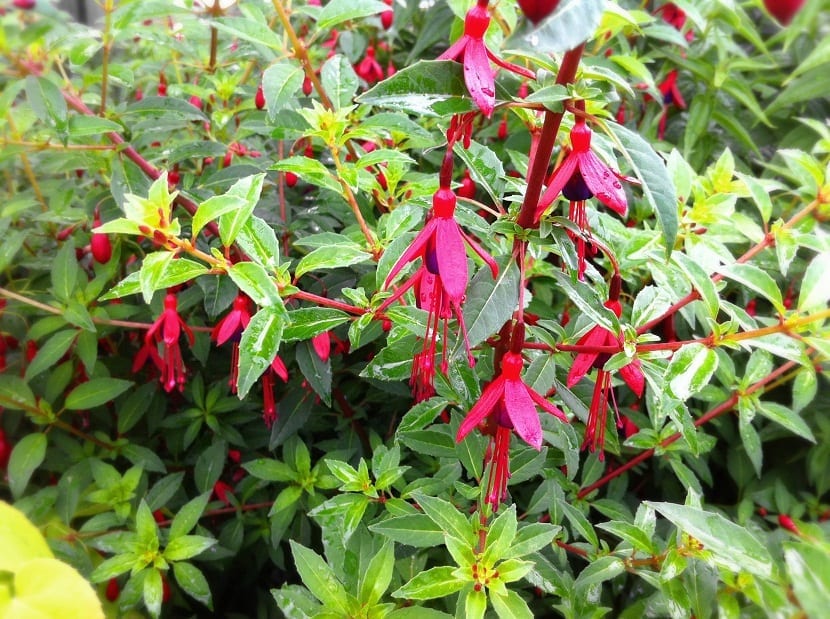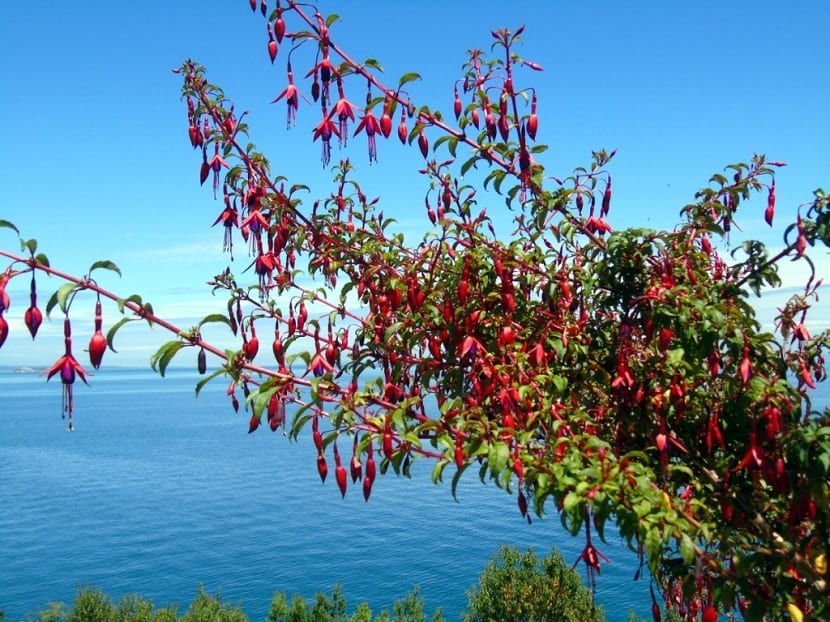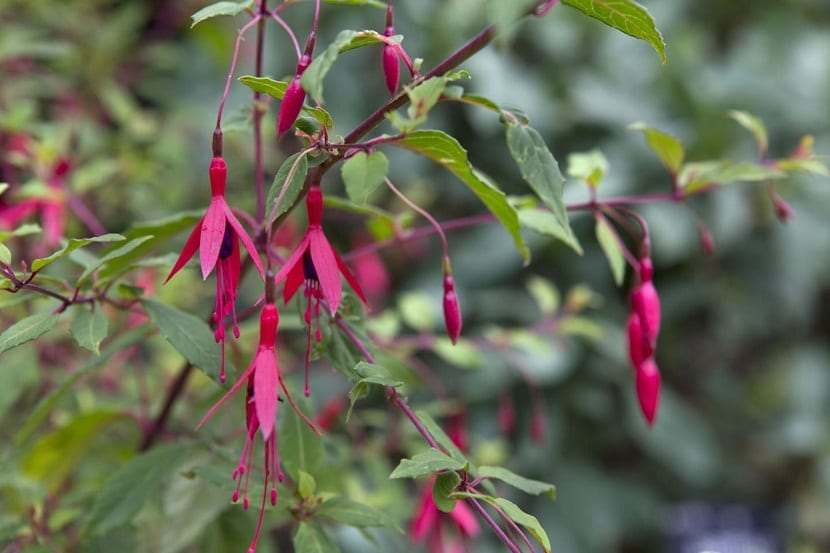
Its name has two meanings, “fuchsia” is due to the French botanist and religious Charles Plumier who named it like this to honor his friend the German doctor Leonhart Fuchs and “magellanica”, who refers to the Strait of Magellan located in the south of Chile, this being one of the South American countries where it originates, as in Peru and Argentina.
Likewise, the shrub that belongs to the Onagrácea family and the Fuchsia genus has a duality of flowers between red and white-pink and it is known as the Queen's Earrings.
Features

The branches are thin, they are born from the foot of the trunk which reaches a size of two to four meters with lanceolate leavess concentrated in androceans that support the beautiful flowers of Fuchsia, a color that suggests its name and those who hang like bells.
They are composed of large red sepals and in whose interior they appear contrasting and tiny purple petals with 8 stamens of the same color.
It holds a long, fleshy berry like fruit called "mountain milcaoIt is consumed in jelly, jam or dehydrated, but be careful if you are pregnant as it can cause abortion.
It develops at the end of spring and summer, next to the waterways, edge of the woods, swamps or lakes and in temperate climates with lots of shade.
Farming
Its reproduction is carried out by cuttings and although it is the most resistant of its species, deteriorates due to continuous cold.
Therefore, if you plant it in your garden, place it in an area where low temperatures do not affect it and the sun's rays do not hit it directly, since the heat or aridity of the environment can lead to reproduction of mites, spider mites, flies and aphids.
Also is susceptible to diseases such as rust and botrytis that decompose their cocoons.
La magellanic fuchsia it has the ability to combine and reproduce by cuttings and occasionally by seeds, unless the gardener wishes to obtain new varieties in tree, hanging or hedge of different colors.
Colors like pink, purple, yellow, white, red even mottled on both its petals and the calyx and crown, being there where its rare condition is based.
Some considerations that you have to take into account to grow this rapidly evolving plant is the climate, then the quality of the soil where you are going to plant it, since must remain moist and fertilized to ensure flowering, (compost, mulch or peat) and it is recommended that it be in autumn and spring.
To keep it lush, remove its dry, broken, diseased branches or that may become entangled. If when working with the cuttings you see their roots on the pot or where it is planted, relocate them immediately to a larger one, since the propagation of its flowers is fast.
Uses

Due to the shades and extravagance of its flowers, product of its hybrid character, used as an ornament, for flower arrangements and in parallel to color the fabrics. In medicine and making an infusion with its leaves, it is used as a reliever of menstrual pain, a diuretic, to lower fever and blood pressure, as well as a purgative.
Pruning
The pruning of this species is oriented in the pinching technique, which lies in pinching the upper apices of the vegetable buds with the thumb and forefinger so that they produce more branches and consequently more flowers, although you can also use scissors.
The only disadvantage is that the first flowers are wasted but a plant with a rounded appearance is achieved, stronger and with an intense flowering especially in summer.
The hummingbird is an excellent pollinator that has a special predilection for the flowers of this shrub due to its tubular shape and hanging position also the nectar and its striking colors. According to specialists, this bird flies from flower to flower looking for enough sweet to replenish energy that it expends in its constant flight.
I have a plant that when new leaves come out have black spots. I have changed places but it is the same.
Hello Pilar.
Do you wet the leaves when you water? It is not good to do it, since the water clogs the pores and can suffocate them, causing the appearance of spots.
Another possibility is that it has fungus, in which case it would have to be treated with fungicides.
Or that the sun shines on it and, not being used to it, it burns out. If so, you have to put it in semi-shade, as it is a plant that does not live well in sunny exposures.
A greeting.
The beautiful plant that you call Pendientes de la Reina (Fuchsia magellanica), both in the Southern Patagonia of Argentina and in Chile we call it: CHILCO.
Atte. I greet you from: Los Antiguos, Province of Santa Cruz, Argentina
I would like you to confirm if the fruit is edible, since my plant is the first time it gives. I cut one and it has a plum scent. I wait your answer.
Greetings.
Hello Jorgelina.
Yes, it is edible.
A greeting.
I would like to know about the double large-flowered ones, they can reach more than 2 meters, they only reach one meter and if so, what can I do to make them grow large?
and reach the height of the Magellanic thanks ^^
Hi Wilbert.
In general, the fuchsias that are marketed are small, 1 to 2 meters maximum.
There is a species, the Fuchsia excorticata, which grows as a 15-meter tree in New Zealand.
Greetings.